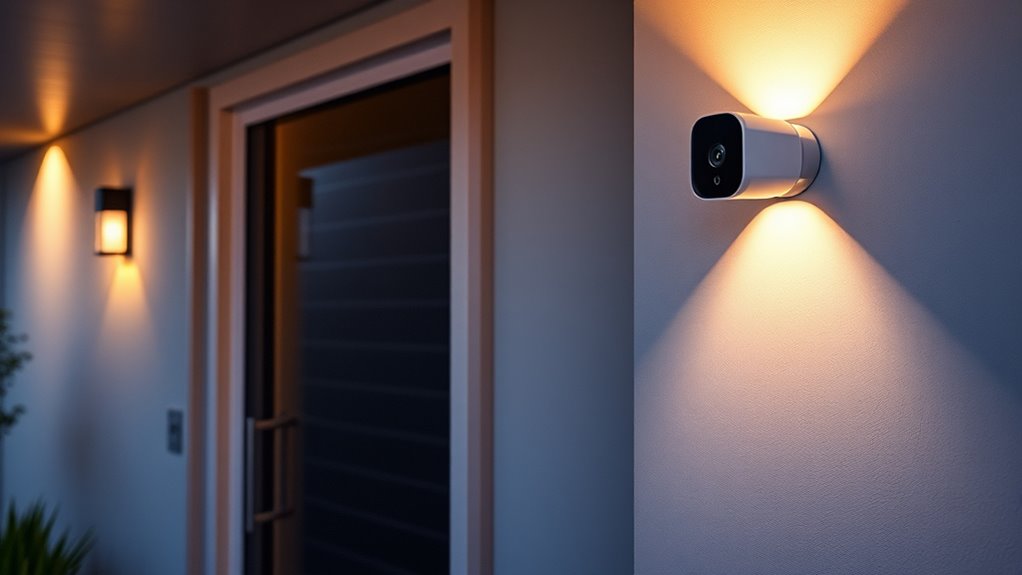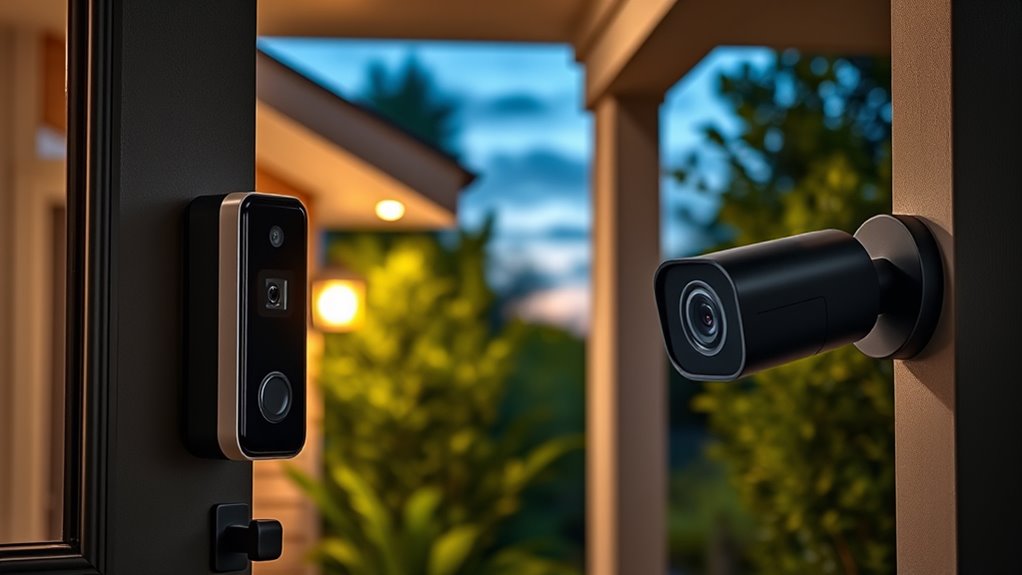Modern home security is evolving with AI-powered cameras and smart doorbells that analyze footage in real-time, reducing false alarms and offering precise alerts. Wireless connectivity makes installation easier and allows you to monitor your home remotely via smartphones. Features like facial recognition, two-way audio, and integration with other smart devices create a more responsive and personalized system. To discover how these innovations can enhance your home’s safety and convenience, explore the latest trends impacting security today.
Key Takeaways
- AI-powered cameras analyze footage in real-time, reducing false alarms and enhancing threat detection.
- Wireless connectivity enables easy installation, remote monitoring, and seamless device integration.
- Smart doorbells and cameras feature facial recognition and two-way audio for improved security and communication.
- The synergy of AI and wireless tech creates adaptable, intelligent security systems that learn user habits.
- Future trends focus on advanced AI capabilities, stronger wireless security, and broader smart home ecosystem integration.

In today’s rapidly evolving world, staying ahead in home security means embracing the latest technological trends. One of the most significant advancements is the integration of AI into security systems. AI-powered cameras and doorbells analyze footage in real-time, distinguishing between humans, pets, and objects, which reduces false alarms and guarantees you’re alerted only when necessary. This smart technology adapts over time, learning your routines and preferences to provide more accurate and timely notifications. With AI integration, your security system becomes more intuitive, proactive, and reliable, giving you peace of mind knowing that potential threats are identified swiftly and accurately. Additionally, ongoing innovations in wireless connectivity continue to enhance the flexibility and ease of installation for modern security setups. Wireless connectivity plays an essential role in modern home security systems. Gone are the days of bulky wiring and complicated installations; today’s smart devices connect seamlessly via Wi-Fi or cellular networks. This wireless setup allows you to monitor your home from anywhere using your smartphone or tablet. Whether you’re at work, on vacation, or just in another room, you can access live feeds, receive alerts, and even control your security devices remotely. The convenience of wireless connectivity means you can add or move devices easily, expanding your security network without extensive rewiring or professional installation. Plus, with advancements in wireless technology, these connections are more stable and secure than ever, minimizing disruptions and safeguarding your privacy.
AI-powered security cameras analyze footage in real-time, reducing false alarms and enhancing overall home safety.
Smart cameras and doorbells are increasingly equipped with features that leverage AI and wireless connectivity to enhance home security. For example, some cameras now include facial recognition, allowing you to identify familiar faces and automatically ignore recognized visitors or delivery drivers. Others have two-way audio, enabling you to communicate directly with anyone at your door, whether you’re home or away. Wireless connectivity ensures these devices stay connected and synchronized, providing a cohesive security network that’s easy to manage. Many systems also support integration with other smart home devices, creating a unified security ecosystem that responds to various triggers—like turning on lights when motion is detected or locking doors automatically.
The combination of AI integration and wireless connectivity makes modern home security both smarter and more flexible. You’re empowered to customize your security setup to fit your lifestyle, with devices that learn and adapt, all while remaining easy to install and control remotely. This technological synergy not only deters intruders more effectively but also offers you a level of convenience and control that traditional systems simply couldn’t match. As these trends continue to evolve, your home security will become more resilient, responsive, and aligned with the demands of today’s digital age.
Frequently Asked Questions
How Do Smart Security Devices Protect Against Hacking?
Smart security devices protect against hacking by using strong encryption protocols, which keep your data safe from intruders. You should also regularly update their firmware, as manufacturers release updates that fix security vulnerabilities. By enabling automatic updates and choosing devices with robust security features, you guarantee your smart home stays protected. Staying proactive and attentive to security practices helps prevent hackers from gaining access to your smart security system.
Are There Eco-Friendly Options for Home Security Systems?
Imagine safeguarding your home while nurturing the planet. Eco-friendly options for home security systems exist, like solar-powered devices that harness sunlight, reducing energy bills and carbon footprints. Some models also feature biodegradable materials, making them easier to recycle. By choosing these greener solutions, you enhance your home’s security and contribute to a healthier environment, all while enjoying peace of mind knowing you’re making a positive impact.
What Are the Legal Privacy Considerations for Smart Cameras?
When using smart cameras, you need to consider privacy laws and data collection rules. You’re responsible for ensuring your cameras don’t infringe on neighbors’ privacy or record areas where people have a reasonable expectation of privacy, like bathrooms or bedrooms. Check local regulations to avoid legal issues, and always inform visitors if cameras are recording. Respecting privacy laws helps prevent legal trouble and keeps your home security ethical.
How Can I Integrate Security Devices With Existing Smart Home Systems?
To integrate security devices with your existing smart home system, start by checking device compatibility. Make certain your new security gadgets work seamlessly with your current platform to avoid integration challenges. Use dedicated apps or hubs that support multiple devices, and follow manufacturer instructions carefully. If you encounter compatibility issues, consider firmware updates or third-party integration solutions to streamline the process and create a cohesive, secure smart home environment.
What Is the Average Lifespan of Modern Security Hardware?
The average lifespan of modern security hardware varies, but you can expect most devices to last around 3 to 5 years. Battery life plays a vital role, often requiring replacement or recharge every few months, depending on usage. Hardware durability is key too; high-quality materials can extend device longevity. Regular updates and proper maintenance help guarantee your security devices stay functional and reliable for as long as possible.
Conclusion
As you embrace modern home security trends, you’re joining millions who prioritize safety with smart cameras and doorbells. Did you know that homes equipped with smart security systems are 30% less likely to be targeted by burglars? This statistic highlights how integrating these technologies can give you peace of mind and a safer home. Stay ahead by continuously exploring innovative security solutions—your safety is worth it.









